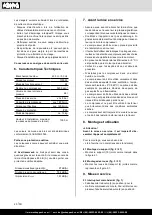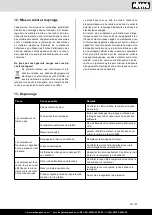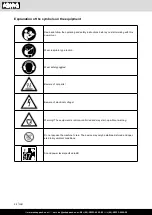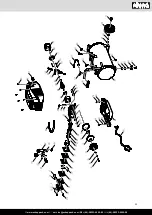
www.scheppach.com /
+(49)-08223-4002-99 /
+(49)-08223-4002-58
30 | GB
• Before you use the machine, make sure that the
mains voltage is the same as the operating voltage
(see the rating plate).
• Long supply cables, extensions, cable reels etc.
cause a drop in voltage and can impede motor
start-up.
• At low temperatures below +5 °C, sluggishness
may make starting difficult or impossible.
10. Electrical connection
The electrical motor installed is connected and
ready for operation. The connection complies
with the applicable VDE and DIN provisions. The
customer‘s mains connection as well as the ex-
tension cable used must also comply with these
regulations.
When working with spray attachments and during
temporary use outdoors, the device must be connect-
ed to a residual current circuit breaker with a trigger
current of 30 mA or less.
Damaged electrical connection cable
The insulation on electrical connection cables is of-
ten damaged.
This may have the following causes:
• Passage points, where connection cables are
passed through windows or doors.
• Kinks where the connection cable has been im-
properly fastened or routed.
• Places where the connection cables have been cut
due to being driven over.
• Insulation damage due to being ripped out of the
wall outlet.
• Cracks due to the insulation ageing.
Such damaged electrical connection cables must not
be used and are life-threatening due to the insulation
damage.
Check the electrical connection cables for damage
regularly.
Make sure that the connection cable does not hang
on the power network during the inspection.
Electrical connection cables must comply with the
applicable VDE and DIN provisions. Only use con-
nection cables with the marking „H05VV-F“.
The printing of the type designation on the connec-
tion cable is mandatory.
AC motor
• The mains voltage must be 230 V~
• Extension cables up to 25 m long must have a
cross-section of 1.5 mm
²
.
Connections and repairs of electrical equipment
may
only be carried out by an electrician.
• Do not install the compressor in a damp or wet
room.
• The compressor may only be used in suitable
rooms (with good ventilation and an ambient tem-
perature from +5 °C to 40 °C). There must be no
dust, acids, vapors, explosive gases or inflamma
-
ble gases in the room.
• The compressor is designed to be used in dry
rooms. It is prohibited to use the compressor in ar-
eas where work is conducted with sprayed water.
•
The compressor may only be used outdoor briefly
when the ambient conditions are dry.
• The compressor must always be kept dry and must
not be left outdoors after work is complete.
8. Attachment and operation
m
Important!
You must fully assemble the appliance before us-
ing it for the first time!
You will require the following tool for assembly:
• open-ended wrench (not included)
8.1 Fitting the supporting foot (fig. 2 / 2.1)
Fit the supplied supporting foot (10) as shown in Fig-
ure 2.1.
8.2 Fitting the wheels (fig. 3 / 3.1)
Fit the supplied wheels (8) as shown in Figure 3.1.
9. Starting up
9.1 ON/OFF switch (fig. 1)
To switch on the compressor, press the button (6) on
position I.
To switch off the compressor, press the button (6) on
position 0.
9.2 Setting the pressure (fig. 5)
You can adjust the pressure on the pressure gauge
(4) using the pressure regulator (3).
The set pressure can be taken from the quick lock
coupling (2).
9.3 Releasing excess pressure
Release the excess pressure by switching off the
compressor and using the compressed air which is
still left in the pressure vessel, e.g. with a compressed
air tool running in idle mode or with a blowout pistol.
9.4 Mains connection
• The compressor is equipped with a mains cable
with shock-proof plug. This can be connected to
any 230 V~ / 50 Hz shock-proof socket which is
protected by a 16 A fuse.







































